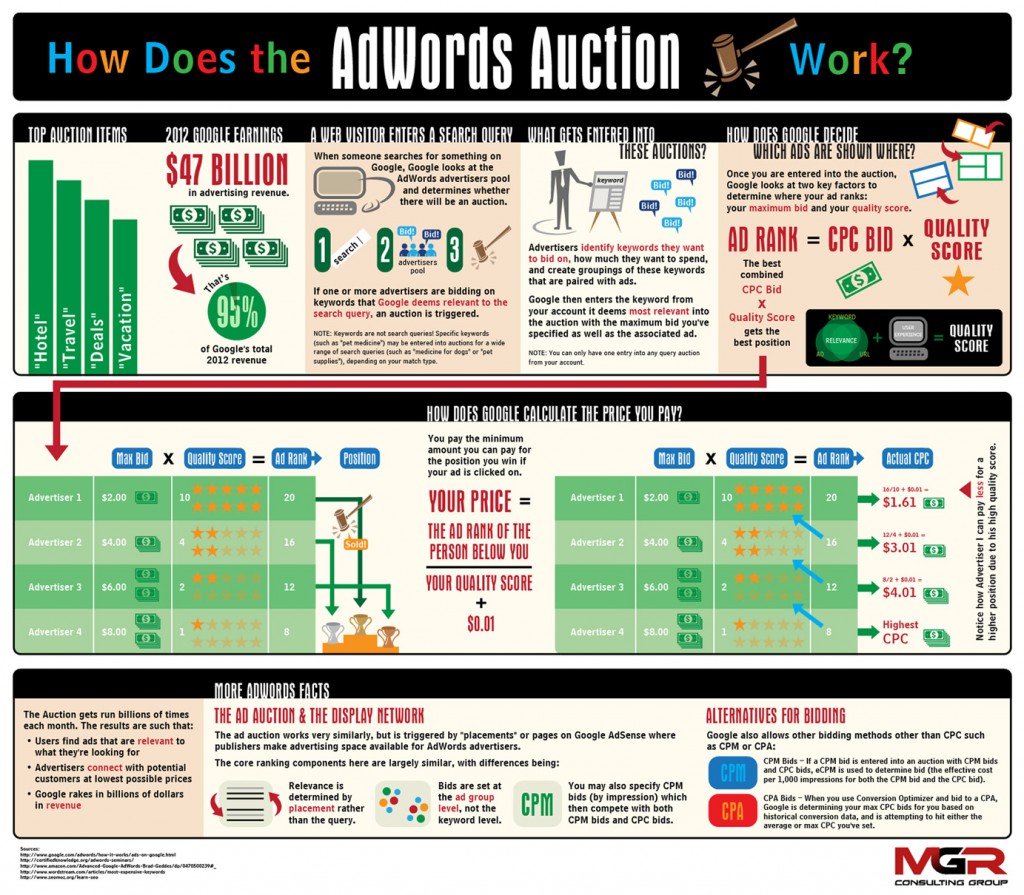
There is a lot of confusion out there –even among some of our most educated clients- about how a Google AdWords campaign works. A great majority of people simply think that you just “Pay-Per-Click” and that the “pay” amount is somehow a fixed cost depending on which keyword they are targeting. Of course, that would be an oversimplification of a much more sophisticated bidding process. The infographic included with this article does a great job explaining the actual bidding process. It’s a busy graphic, but relatively easy to understand once you move from section to section.
Google’s AdWords page also explains in overall terms how the ad auction works. The important fact to remember is that your Ad Rank will be determined by your Maximum Bid and your Quality Score.
Ad Rank = Max Bid X Quality Score
Where “Ad Rank” is how high your ad appears on the results page and “Max Bid” is your maximum pay-per-click bid. Now, when it comes to “Quality Score” is when things start to get a bit more interesting. The “Quality Score” number is how Google views your overall ad, the web page that it links to and how it relates to the keyword for which you’re bidding. In other words, Google is giving you a “Quality Score” based on how RELEVANT your ad is and how positive the USER EXPERIENCE will be once they arrive to your website.
Why is it important? Simple. Remember that Google only gets paid when people click on your ads, so they will naturally favor ads that people are likely to click. In other words, it’s not just about how much you’re willing to bid (Max Bid), but also how frequently Google thinks people will click on your ad.
How Can You Increase Your Quality Score?
Quality Score is Google’s rating of the quality and relevance of both your keywords and PPC ads. It is used to determine your cost per click (CPC) and multiplied by your maximum bid to determine your ad rank in the ad auction process. Your Quality Score depends on multiple factors, including:
- Your click-through rate (CTR).
- The relevance of each keyword to its ad group.
- Landing page quality and relevance.
- The relevance of your ad text.
- Your historical AdWords account
No one outside of Google knows exactly how much each factor “weighs” in the Quality Score algorithm, but we do know that click- through rate is the most important component. When more people who see your ad click it, that’s a strong indication to Google that your ads are relevant and helpful to users. Accordingly, Google rewards you with:
Higher Ad Rank = Lower Bid Cost
 Based on the above, you don’t need to be a math genius to figure out that if your Quality Score is very low, you’re going to pay a lot for each click to achieve a certain Ad Rank, whereas another advertiser that has a much higher Quality Score will pay much less cost per click for the same keyword. If you have a website or landing page that contains authoritative and fresh content, optimized for your visitors and relevant for the keywords and ads that you’re bidding for, even if your competition bids higher than you (spending more per click) you can still achieve a higher ad rank at a lower price.
Based on the above, you don’t need to be a math genius to figure out that if your Quality Score is very low, you’re going to pay a lot for each click to achieve a certain Ad Rank, whereas another advertiser that has a much higher Quality Score will pay much less cost per click for the same keyword. If you have a website or landing page that contains authoritative and fresh content, optimized for your visitors and relevant for the keywords and ads that you’re bidding for, even if your competition bids higher than you (spending more per click) you can still achieve a higher ad rank at a lower price.
Low AdWords Quality Scores are primarily the result of disconnect between keywords, ad groups, ad text, and landing page content. A high Quality Score comes naturally when an AdWords account contains organized keywords in appropriate keyword groups, ad text that corresponds with certain ad groups, and landing pages that connect with the ad text’s offer. While there is no easy, foolproof answer to improving your Quality Score formula, paying careful attention to relevance will greatly improve your scores.
I often advise my clients that it is more important to work on their organic rankings first and their AdWords campaign second. Of course, everyone wants the instant gratification that you can achieve by buying your way to the top; in the long run, if you follow a consistent and thorough organic optimization program that also targets certain relevant keyword phrases and establishes your authority, when it comes to adding your AdWords campaign to the mix, you will have half of the work done and you will be able to achieve a higher Ad Rank at a much lower cost.
If your head is spinning by now, hopefully the infographic attached to this article will help you visualize better what happens behind the scenes. And as always, if you have any questions, please feel free to contact our SEO-SEM Team at MGR Consulting Group.
Thank you for reading. Until next time, this is Manuel Gil del Real (MGR).





